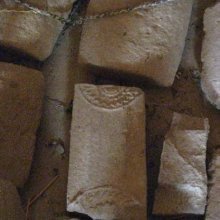Lotus-medallion: 1 definition
Introduction:
Lotus-medallion means something in the history of ancient India. If you want to know the exact meaning, history, etymology or English translation of this term then check out the descriptions on this page. Add your comment or reference to a book if you want to contribute to this summary article.
Images (photo gallery)
India history and geography
Source: Singhi Jain Series: Ratnaprabha-suri’s Kuvalayamala-katha (history)Lotus-medallions commonly decorated the Vimānas (temple complex) of ancient India, as vividly depicted in the Kathās (narrative poems) such as Uddyotanasūri in his 8th-century Kuvalayamālā (a Prakrit Campū, similar to Kāvya poetry).—Page 92.24-31: A Devī-vimāna is described as being decorated with rubies, pearls-pendants and festoons, rows of bells attached to banners, rows of vaijayantī flags fixed on the top, lotus-medallions formed by the inset work of rubies, figures of the lotus-pond and thus giving appearance of Padma-vimāna. [...]

The history of India traces the identification of countries, villages, towns and other regions of India, as well as mythology, zoology, royal dynasties, rulers, tribes, local festivities and traditions and regional languages. Ancient India enjoyed religious freedom and encourages the path of Dharma, a concept common to Buddhism, Hinduism, and Jainism.
See also (Relevant definitions)
Partial matches: Lotus.
Full-text: Vyalamukha, Devivimana, Flag, Padmavimana, Festoon, Ruby, Bell, Vaijayanti, Dhvajapata, Kinkinimala, Kinkini, Vimana, Pearl.
Relevant text
Search found 4 books and stories containing Lotus-medallion; (plurals include: medallions). You can also click to the full overview containing English textual excerpts. Below are direct links for the most relevant articles:
Amaravati Art in the Context of Andhra Archaeology (by Sreyashi Ray chowdhuri)
Lower Kṛṣṇā Valley (6): Goli < [Chapter 2 - Amarāvatī and other Archaeological Sites of Ancient Andhra Pradesh]
Epigraphs from Amarāvatī (a) The Gahapati and Setti classes < [Chapter 4 - Survival of Amarāvatī in the Context of Andhra Art]
Lower Kṛṣṇā Valley (18): Bavikoṇḍa < [Chapter 2 - Amarāvatī and other Archaeological Sites of Ancient Andhra Pradesh]
Stupas in Orissa (Study) (by Meenakshi Chauley)
During the time of Sunga’s < [Chapter 2]
Major Stupas at Langudi < [Chapter 4]
Development of the Stupa and its parts < [Chapter 3]
Pallava period (Social and Cultural History) (by S. Krishnamurthy)
Architecture of the Mahendra style < [Chapter 2 - Origin of Sculptural Art—Its Development and Scheme]
Depiction of Flora < [Chapter 4 - Material Culture of the People]
Jainism in Odisha (Orissa) (by Ashis Ranjan Sahoo)
Iconography of Tirthankaras < [Chapter 6]
